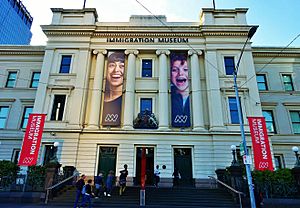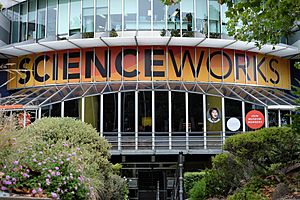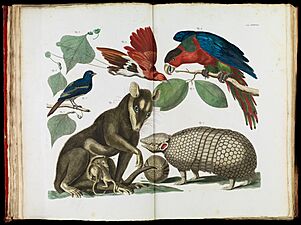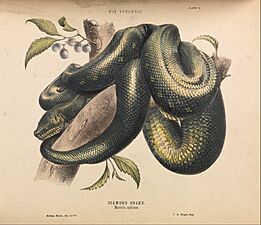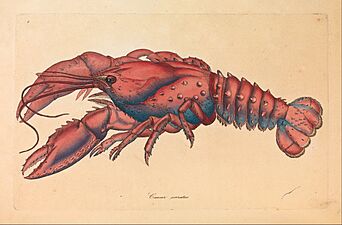Museums Victoria facts for kids
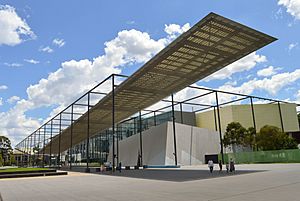
Melbourne Museum, Museums Victoria's main campus
|
|
| Former name | Museum of Victoria, Museum Victoria |
|---|---|
| Established | 1854 |
| Location | Melbourne, Victoria, Australia |
| Type | Natural history, cultural history, and science and technology |
| Founder | Frederick McCoy |
Museums Victoria is a big organization in Melbourne, Australia. It runs several cool museums and other important places. These include the Melbourne Museum, Immigration Museum, and Scienceworks. It also manages IMAX Melbourne, a research center, and the Royal Exhibition Building. This building is so special it's listed as a UNESCO World Heritage site!
Museums Victoria takes care of over 15 million items. These items tell the story of nature, society, and culture in Australia and nearby regions. This huge collection has been growing for almost 200 years. It helps scientists do important research about our world. Their natural history collections are especially helpful for understanding how the environment is changing. This research helps create plans to protect different plants and animals.
In 2022, Museums Victoria started a new research center called the Museums Victoria Research Institute. This institute looks at big challenges facing our world today. It uses different types of knowledge to help us understand things better.
Museums Victoria also has a library. This library holds some of Australia's rarest and most beautiful science books from the 1700s and 1800s.
The organization works closely with First Peoples. They make sure that First Peoples' cultures, histories, and knowledge are central to what they do. They work with Elders and community members to return cultural items and knowledge to their traditional lands. Together, they create exhibitions that share stories from thousands of years ago. This helps young people today understand the rich and lively Aboriginal and Torres Strait Islander cultures.
More than 2 million people visit Museums Victoria's sites every year. They are some of the most popular places to visit in Victoria. Beyond the museum buildings, their online programs reach over 10 million people each month. They also help with education in Victoria. They offer programs for young children and focus on improving science, technology, engineering, and math (STEM) skills for everyone.
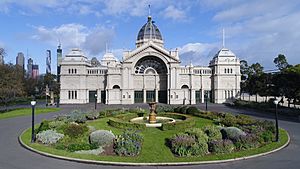
Contents
History of Museums Victoria
The story of Museums Victoria began in 1854. That's when the "Museum of Natural and Economic Geology" was created. William Blandowski and others helped start it.
For a while, the museums were connected to the Public Library and the National Gallery of Victoria. This happened in 1869. But in 1944, they became separate organizations again.
Museums Victoria was officially formed in its current way in 1983. Today, its collections hold over 17 million items. These include objects about Indigenous Australian and Pacific Islander cultures, rocks, history, ancient life (palaeontology), technology, and animals. The library also has very old and rare science books.
Here are some important moments in the museum's history:
- 1854 – The "Museum of Natural and Economic Geology" was founded.
- 1856 – Collections moved to the University of Melbourne.
- 1858 – Frederick McCoy became the first "director."
- 1862 – A new building opened, and the museum was renamed "National Museum of Victoria."
- 1869 – The National Museum, an early Industrial & Technological (I&T) Museum, the National Gallery of Victoria, and the Public Library of Victoria joined together.
- 1870 – The I&T Museum opened on Swanston Street.
- 1899 – The National Museum moved into the I&T Museum's building.
- 1944 – The museums became separate from the Library and National Gallery again.
- 1945 – The I&T Museum was renamed the Museum of Applied Science (MAS).
- 1971 – The Museum of Applied Science was renamed Science Museum of Victoria.
- 1983 – The National Museum of Victoria and the Science Museum of Victoria joined to form the Museum of Victoria.
- 1992 – Scienceworks opened in Spotswood.
- 1998 – The Museum of Victoria was renamed Museum Victoria. The Immigration and Hellenic Antiquities Museum opened.
- 2000 – The Melbourne Museum opened at Carlton Gardens.
- 2016 – Museum Victoria was renamed Museums Victoria.
Leadership
The current leader of Museums Victoria is Lynley Crosswell. She used to be in charge of the Australian Broadcasting Corporation's international section. Lynley Crosswell is the first woman to lead this organization in its history.
Here are some of the past directors:
- 1858 – Frederick McCoy
- 1899 – Walter Baldwin Spencer
- 1928 – James A. Kershaw
- 1931 – Daniel James Mahony
- 1957 – Charles. W. Brazenor
- 1962 – John McNally
- 1979 – Barry Wilson
- 1984 – Robert Edwards
- 1990 – Graham Morris
- 1998 – George F. MacDonald
- 2002 – Dr J. Patrick Greene
Amazing Collections
Museums Victoria has been collecting and studying items since 1854. They record Australia's natural and cultural history.
Today, Museums Victoria has about 15 million items. These are kept safely in special storage areas at Melbourne Museum, Scienceworks, and another storage building. Experts called collection managers, conservators, and curators work to research, record, and protect these collections. They make sure these items are safe for people now and in the future.
The collections cover many areas, including:
- Geology (rocks and Earth's history)
- Historical studies (human history)
- Indigenous cultures (First Peoples' heritage)
- Library (books and documents)
- Palaeontology (fossils and ancient life)
- Technology and society (how technology affects us)
- Zoology (animals)
Museums Victoria Research Institute
The Museums Victoria Research Institute started in 2022. It's based at Melbourne Museum. This institute has changed how Museums Victoria does research. It uses the organization's strengths to tackle some of the biggest and most complex problems of our time.
The Library Collection
The Museums Victoria Library started in the 1850s. It was a collection of books for the museum's experts. Now, it's one of the best collections of natural history books and journals in Australia. The library was at Melbourne University until 1906. Then it moved to be with the Public Library.
Today, the library is at Melbourne Museum. It has 40,000 titles. About 1,000 of these are considered rare. This could be because they are very valuable, hard to find, beautiful, or important for history or science. The library is especially strong in natural history, like zoology, geology, and palaeontology. It also has scientific expedition reports, journals, books on Indigenous cultures, Australian history, and technology.
Many items from the Museums Victoria Library have been put online. You can find them on the Biodiversity Heritage Library. Museums Victoria is where the Australian part of this project is based. The work to put these items online is funded by the Atlas of Living Australia.
Featured Works
-
A double plate from Albertus Seba's Thesaurus
-
Plate 8 from Zoology of New Holland by George Shaw
-
Illustration of a potoroo from Voyage autour du monde by Louis de Freycinet
-
Granulated Cuttle illustration from The Naturalist's Miscellany by George Shaw
-
Illustrated plate from On the marsupial pouches, mammary glands and mammary foetus of the Echidna hystrix by Richard Owen


